Key Insights
- The NFTimbre platform by La Poste Group and Nomadic Labs sold 18,200 NFT stamps. This initiative netted over €145,000 ($153,000), merging traditional philately with crypto.
- Tezos ranks 18th with 250 developers as of September 2023, according to Electric Capital data.
- Fireblocks integrates Tezos (XTZ) custody. This addition facilitates a gateway for increased institutional involvement in the Tezos ecosystem.
- Oxford, Tezos’ 15th protocol proposal, did not achieve a supermajority and returned to the proposal stage. Once approved, it will bring dynamic XTZ issuance and a revamped staking mechanism.
Primer on Tezos
Tezos is a Liquid Proof-of-Stake (LPoS) blockchain network, characterized by energy-efficient consensus with low power consumption. It utilizes its Michelson Virtual Machine for formal verification of smart contracts. The network features on-chain governance and self-amending functionality, enabling stakeholders to participate in voting for protocol upgrades that are subsequently implemented without requiring a network hard fork. To date, Tezos has undergone fourteen forkless network upgrades.
Tezos is enhancing its scalability through Smart Rollups and a Data Availability Layer. Smart Rollups, introduced in the Mumbai protocol upgrade, move transaction executions to Layer-2, increasing throughput. The Data Availability Layer, running parallel to Tezos’ Layer 1, ensures data availability leveraging the Tezos validators.
Tezos has a vibrant NFT ecosystem, attracting a diverse community of developers, artists, and entrepreneurs. NFTs constitute a significant portion of the Tezos ecosystem. Additionally, Tezos has partnerships with Unity and Ubisoft in the gaming sector and has an expanding presence in the DeFi space.
Key Metrics
Financial Overview
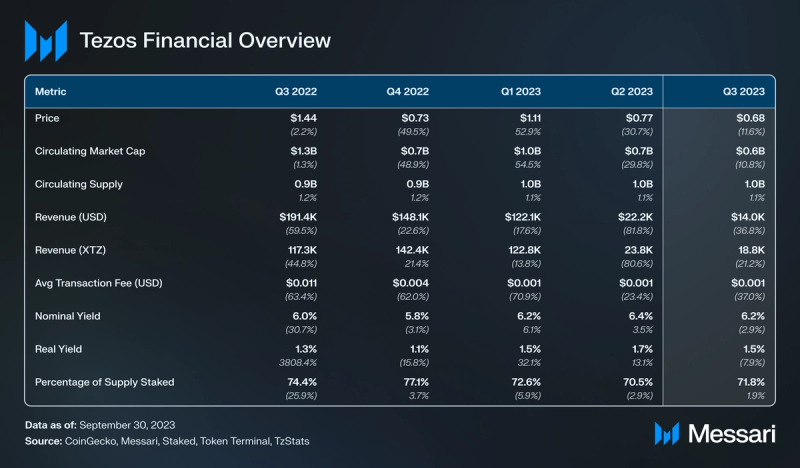
Market Capitalization
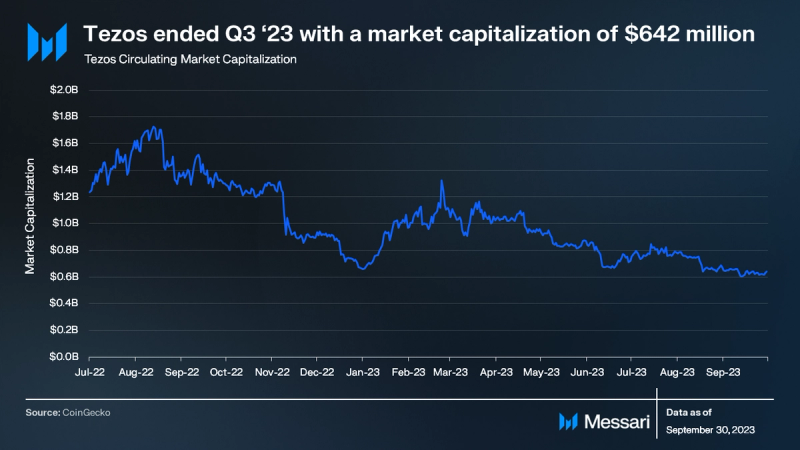
In Q3 2023, despite favorable court rulings for XRP and Grayscale, the overall crypto market experienced a moderate downturn. The total crypto market capitalization decreased by 5.8%, while BTC and ETH fell by 7.5% and 10.0%, respectively. Tezos’s market capitalization declined by 11% QoQ, closing at $642 million, making it the 60th largest crypto protocol by market cap.
Revenue

In Q3 ‘23, Tezos’s revenue, derived from network transaction fees (excluding storage costs), decreased by 37% QoQ, dropping from $22,000 to $14,000. The drop was due to reduced transactions and smart contract calls (further detailed in the Network Overview section). Concurrently, the combination of decreased transaction volume and the XTZ price led to a 37% QoQ reduction in the average transaction fee, settling at $0.001.
Supply
The native token of Tezos, XTZ, performs multiple roles in the network, such as serving as a medium of exchange, covering gas fees, staking, delegation, rewarding validators, and facilitating governance. As of the end of Q3 ‘23, the annual inflation rate for XTZ is fixed at 42 million tokens, which constitutes 4.3% of the current circulating supply of 976 million XTZ. The Mumbai upgrade adjusted the block time to 15 seconds and reduced the block rewards to 20 XTZ, in an effort to maintain this annual inflation rate.
The upcoming Oxford upgrade intends to modify the XTZ inflation rate through the implementation of Adaptive Issuance. This mechanism dynamically adjusts XTZ issuance based on the ratio of staked XTZ to the total supply. The objective is to maintain a defined target ratio of 50% staked funds, allowing the network to alter the issuance rate to either incentivize or disincentivize staking.
Stakers on Tezos currently earn a nominal annual staking yield of 6.2%, and a real yield of 1.5%.
Network Overview
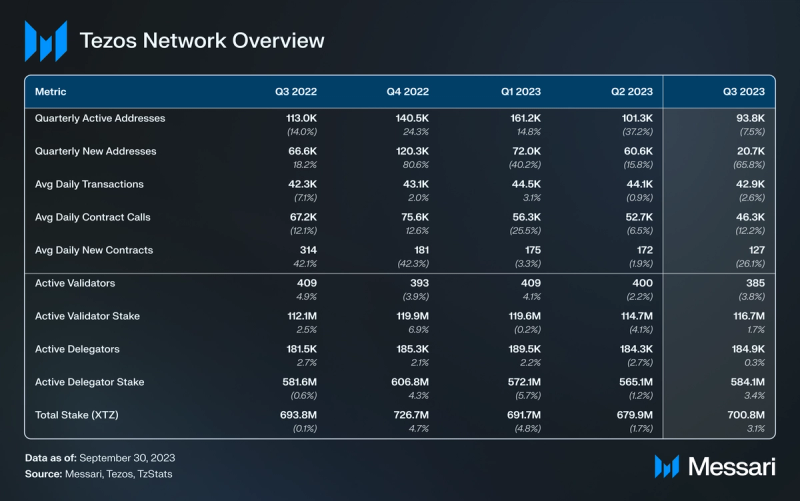
Usage

In Q3 ‘23, Tezos experienced an 8% QoQ decline in active addresses, decreasing from 101,000 to 94,000. New addresses also declined, with a 66% drop from 61,000 to 21,000. The surge in activity during Q4 ‘22 and Q1 ‘23 was attributed to the minting of Manchester United NFTs and McLaren F1 NFTs.
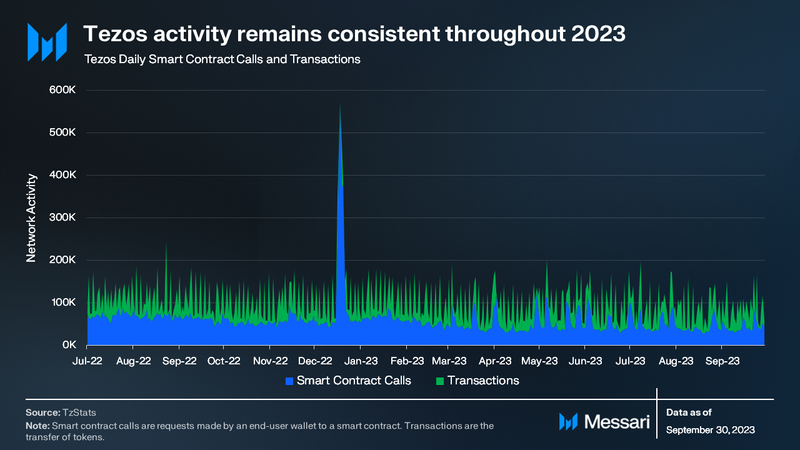
Usage on the Tezos crypto network is measured through the analysis of smart contract calls and transactions. Smart contract calls represent user-initiated requests to interact with smart contracts, while transactions involve the transfer of tokens.
During Q3 ‘23, Tezos displayed consistent usage levels when compared to previous quarters. Tezos recorded an average of 46,000 daily smart contract calls, representing a 12% decrease from the previous quarter. Additionally, there was an average of 43,000 daily transactions, indicating a 3% decline QoQ. NFTs remain the key driver of activity on Tezos, while DeFi applications continue to see greater adoption.
The Mumbai upgrade, launched in March, marked a significant milestone for Tezos. This upgrade introduced Smart Rollups, which enhanced the network’s capabilities. Smart Rollups enable increased throughput, support for new execution environments, and improve scalability, security, and functionality. The Nairobi upgrade in June introduced an 8X increase in transactions per second.
Development
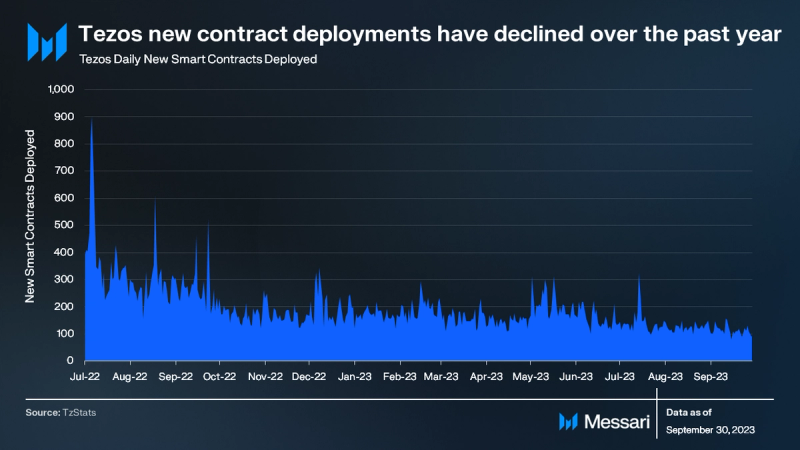
The Q1 ‘23 Mumbai upgrade introduced significant changes to the Tezos development landscape. It integrated Smart Rollups and allowed for the creation of applications on Tezos using any language that compiles to WASM. Languages that are now compatible with this feature encompass Rust, C/C++, Go, and Python. The Q2 ‘23 Nairobi upgrade expanded the capabilities of Smart Rollups and escalated the Smart Rollups TPS by a factor of 8. According to Electric Capital, as of September 2023 Tezos has the 18th largest developer base in crypto with 250 developers.
Several key developer-centric events took place in Q3 2023:
- Blockwatch introduced TzPro. This toolset consists of APIs and SDKs, presenting a consistent data model and three distinct API layers. These features facilitate the efficient incorporation of Tezos functionalities into DeFi, NFT, and identity-based solutions.
- The TezAsia Hackathon 3.0 took place, recording over 3,000 participants. Monetary incentives included $30,000 in prizes with additional grants that could reach up to $100,000.
- Tez/Dev 2023 was held in Paris. The annual conference attracted a diverse group of enthusiasts and developers. The agenda featured presentations, workshops, and panel discussions led by various entities within the Tezos ecosystem.
- Taquito, a tool intrinsic to the Tezos ecosystem, received substantial updates following Nairobi.
- Baking Bad unveiled enhancements specifically designed to augment Smart Rollup development on the Tezos platform.
- LigoV1 was released as a comprehensive overhaul of the Ligo smart-contract language.
Despite these advancements and events, Tezos has witnessed a decline in new contract deployments for four consecutive quarters.
Decentralization and Security
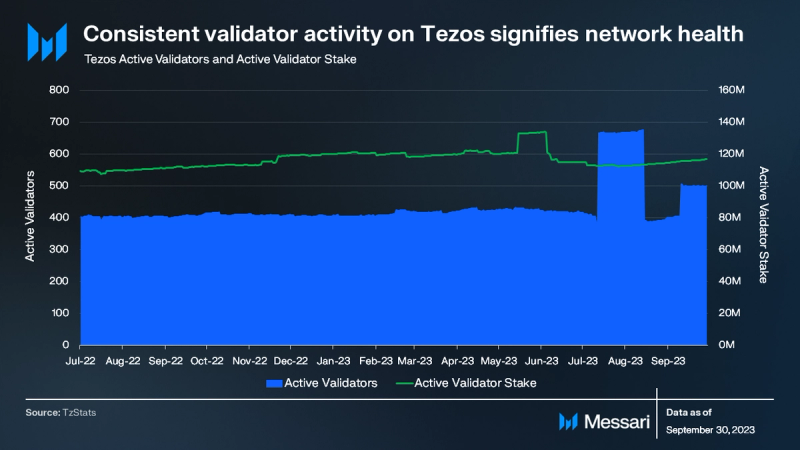
Tezos uses a Liquid Proof-of-Stake (LPoS) consensus mechanism. Tezos ended Q3 ‘23 with 385 active validators with a total stake of 117 million XTZ. Tezos’ validator stake distribution remains aligned with industry norms. Everstake is the largest validator holding a 6.6% share, followed by PoSDog (5.1%), stakefish (4.7%), P2P.org (2.6%), and Chorus One (2.2%). Additionally, Tezos’ validator set is globally diverse.
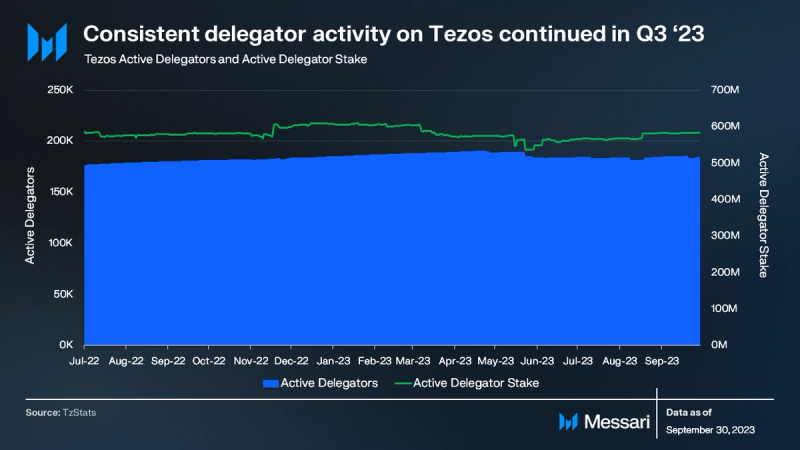
Active delegators on Tezos saw an increase for eight successive quarters until a moderate decline occurred in Q2 2023. In Q3 ‘23, both the number of active delegators and the total delegator stake remained consistent QoQ, indicating that the Q2 decline did not signal an emerging broader trend. As of the end of Q3 ‘23, Tezos had 185,000 active delegators holding a collective stake of 584 million XTZ.
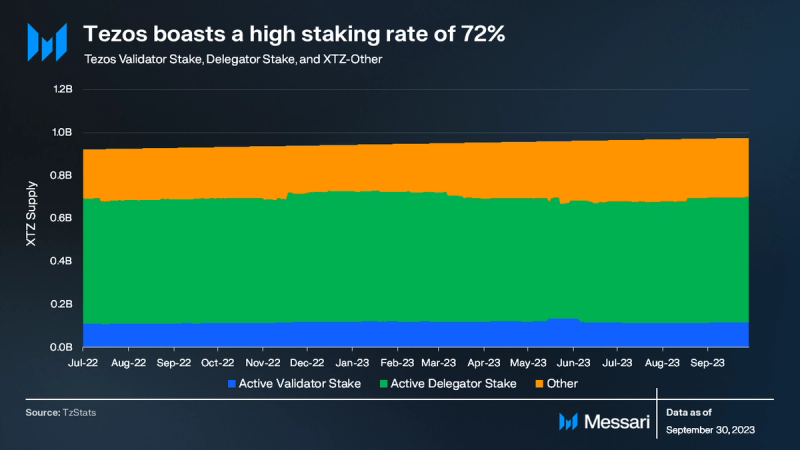
As of the end of Q3 ‘23, there were 976 million XTZ in circulation. Out of the total supply, 701 million XTZ (72%) was staked. Of the staked XTZ, 584 million (83%) comes from delegators, while validators self-staked 117 million XTZ (17%). The percentage of supply staked has remained consistently around 70%, indicating a long-term commitment to the network by stakeholders. Tezos has a high staking rate relative to other base layer protocols.
The Oxford upgrade introduces key modifications to staking economics and validator operations, including Adaptive Issuance and a new ‘staker’ role. Adaptive Issuance adjusts XTZ issuance based on the percentage of supply staked ratio, targeting a 50% staking ratio. It requires a subsequent baker vote for activation. The new staker role, dependent on Adaptive Issuance approval, allows XTZ holders to support a validator’s security deposit while retaining custody of their XTZ. The upgrade also replaces automatic freezing and unfreezing of staked balances with new “stake” and “unstake” operations.
Governance
Tezos is a self-amending blockchain that removes the need to hardfork by employing on-chain governance for protocol upgrades. Users delegate their XTZ to validators who participate in stake-weighted voting; therefore, validators are responsible for both consensus and governance. The governance process is split into five periods totaling approximately 2 months and 10 days.
To further bolster governance, Tezos created the Tezos Ecosystem DAO, responsible for managing and allocating XTZ for community projects. Initial funding for the DAO came from NFT sales on Objkt and donations from ecosystem participants. In Q3 2023, the Tezos Foundation contributed 72,000 XTZ (equivalent to $50,000) to the DAO, which was also listed on The PASS during the same period. Additionally, Marigold launched Tezos Community in Q3 2023, a centralized platform designed to foster engagement, networking, and collaboration within the Tezos ecosystem.
The Tezos Foundation has announced that Alexis Bonte has been appointed as the President of the Foundation Council, effective from Oct. 10, 2023. Jean-Frédéric Mognetti will assume the position of Executive Director beginning on Oct. 10, 2023. Former President, Roman Schnider, has chosen to step down from the presidency to “start his own venture,” and will retain his position as a member of the Foundation Council.
Network Upgrades
Oxford Upgrade
The Oxford upgrade, Tezos’ 15th protocol proposal, spearheaded by various development teams, aims to revamp its staking economics to bolster real-world utility and enhance the staking process. It contains two major upgrades:
- Adaptive Issuance: Dynamically adjusts XTZ issuance based on the ratio of staked XTZ to total supply, aiming for a 50% staking ratio.
- New Staking Mechanism: Introduces a ‘staker’ role alongside existing delegators, enabling XTZ holders to contribute to a validator’s security deposit while retaining custody of their XTZ.
Additional modifications in the Oxford proposal include refinements to PoS penalties and rewards, timelocks re-enabled, and further improvements to smart rollups. The Oxford upgrade failed to reach a supermajority and the governance process has reverted back to the proposal phase. Core developers are re-designing the staking system, and features of Oxford are likely to change.
Rollups
Tezos has advanced its rollup infrastructure, with the implementation of WebAssembly (WASM) rollups spearheaded by teams like Baking Bad and Plenty. Additionally, an Ethereum Virtual Machine (EVM) Smart Rollup developed by Trilitech, Marigold, Functori and Nomadic Labs has been introduced on the Ghostnet testnet. Moreover, Etherlink, a decentralized EVM Layer-2 is building on Tezos.
Looking ahead, Tezos plans to merge optimistic and validity rollup solutions into a hybrid model, blending the strengths of both technologies. This hybrid optimistic/ZK-rollup aims for a gradual integration of zero-knowledge technology, reflecting Tezos’ ongoing efforts to enhance its rollup infrastructure for better scalability and interoperability. Furthermore, Tezos architect Arthur Breitman hinted at the development of an all-in-one Ultra-High Throughput Rollup.
Data Availability Layer
The introduction of Smart Rollups in the Mumbai upgrade marked a significant advancement in Tezos’ scalability potential. As Tezos continues to pursue its goal of achieving millions of transactions per second, the development of a robust data availability solution becomes crucial. To address this challenge, Tezos core developers are working on a protocol-level solution called the Data Availability Layer (DAL).
The DAL will run in parallel with the Tezos Layer-1 as an independent peer-to-peer network. It will leverage Tezos bakers and guarantee data availability while significantly scaling bandwidth and storage capacity. The DAL is currently in development, with an early version available on the Mondaynet testnet, and is expected to be activated through a protocol upgrade in early 2024.
Ecosystem Overview
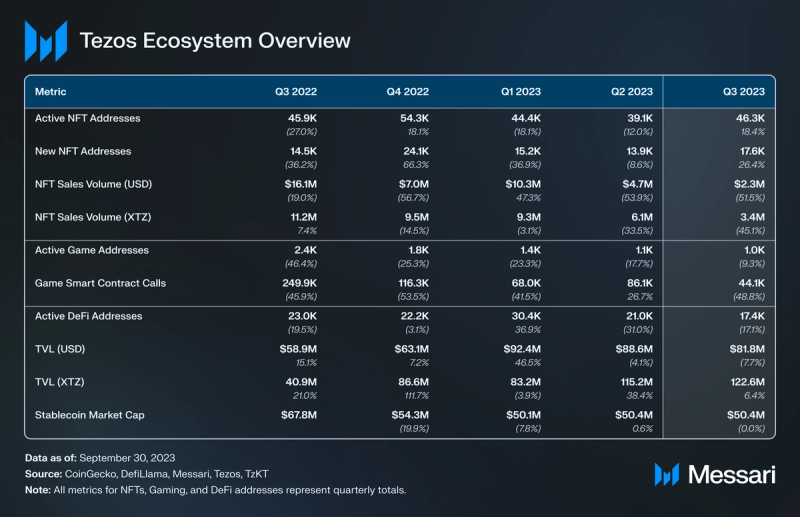
Leading Protocols
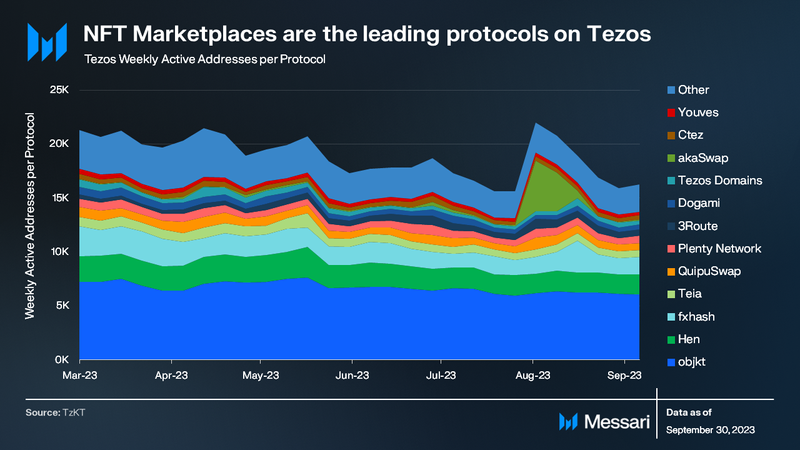
Tezos’s top protocols by active addresses are predominantly NFT marketplaces. Objkt leads with 6,300 weekly active addresses, followed by Hen with 1,900, and fxhash with 1,600. In Q2 ‘23, fxhash released fxhash 2.0 on Ethereum, bringing added features for artists. In Q3 ‘23, fxhash secured $5 million in seed funding from investors including 1kx, Fabric Ventures, Bright Opportunities DAO, Union Square Ventures, the Tezos Foundation, among others. Another notable announcement was Teia’s introduction of the TEIA token.
Outside of NFT Marketplaces, DeFi DEXs Plenty Network and QuipuSwap, along with aggregator 3Route, each averaged approximately 700 weekly active addresses. In the gaming sector, Dogami is the top game by active addresses, logging 400 on a weekly basis.
Re—tain, an upcoming Tezos NFT marketplace, has announced that over 100 artists are registered for its platform launch.
NFTs

Active NFT addresses on the network increased by 18% in Q3, with new NFT addresses rising by 26%. Despite this growth, both the USD and XTZ NFT sales volumes declined by nearly 50% QoQ. This decrease in sales volume has been a consistent trend over the past year.
Despite the decline, Tezos remained active in the NFT space with a series of announcements and partnerships. In Q2 ‘23, Billy partnered with Hellfest festival, the annual Tezos NFT Summit took place in New York, Manchester United expanded its NFT exhibit, Grammy-winning group TLC partnered with SongVest and Oneof to offer fractionalized royalties, and DNS.xyz revealed plans to launch a social platform on Tezos.
Highlights from Q3 ’23 in the Tezos NFT sector included:
- A collaboration involving artists Vincent D’Onofrio and Laurence Fuller with NFT artist Sutu resulted in “Sparrow,” a blockchain-driven digital art initiative.
- La Poste Group and Nomadic Labs launched the NFTimbre platform and sold 18,200 NFT stamps, netting more than €145,000. significant evolution in stamp collecting, making it more accessible and modern.
- The Tezos Foundation entered into a year-long collaboration with the art and culture establishment, Musée d’Orsay.
- McLaren Racing sold out its McLaren Moments NFT collection on the Tezos network, allowing enthusiasts to digitally commemorate significant milestones in the team’s timeline, which subsequently sold out.
- The Tezos Foundation and Champ Medici Announce First Cohort of Recipients for $1 Million Arts Fund.
Gaming
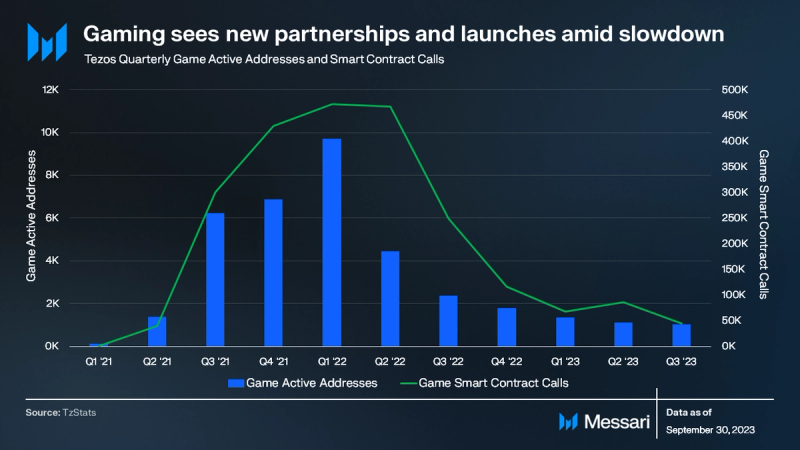
Tezos gaming saw its active addresses decline for the sixth consecutive quarter, totaling 1,000 active game addresses in Q3 ‘23. Following a Q2 ‘23 resurgence, game smart contract calls also witnessed a downturn, recording a 50% QoQ drop to 44,000 total game smart contract calls.
Despite the decline in gaming activity, the Tezos gaming sector continues to see announcements and partnerships. In Q4 ‘22, Tezos established partnerships with major game developers Ubisoft and Unity. The Ubisoft partnership resulted in the creation of UbisoftQuartz, a platform allowing players to acquire NFTs for Ghost Recon Breakpoint. Unity released a software development kit (SDK) for Web3 game development on Tezos in Q1. Further, Q2 ‘23 was marked by several game introductions and collaborations, including Cricket Stars, VPoker, and The Six Dragons.
For Q3 ‘23, the gaming announcements on Tezos included:
- The introduction of Crossroads: Myth, an interactive world featuring varied campaigns, multiple game modalities, and player-centric tokenomics.
- A collaborative event between Block Born and Tezos, named the 90’s Arcade Jam, merging classic arcade gameplay with contemporary gaming technology.
- Trilitech and Gangbusters are set to elevate the BattleTabs game by amalgamating it with the Tezos blockchain, introducing NFTs called “BattleTabs Cards”.
- KAYO is a new game merging street combat with strategic gameplay where players guide AI-powered fighters with distinctive skills.
- Third World: The Bottom Dimension melds entertainment with an exploration into art, history, and culture, showcasing Brazilian artists, diverse character narratives, and engrossing Latin American-themed settings.
DeFi
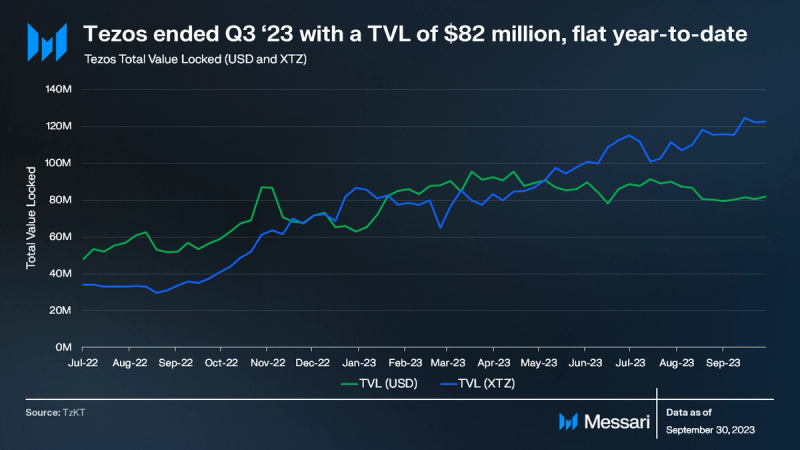
Tezos’s TVL (USD) observed an 8% QoQ drop, from $89 million to $82 million. In contrast, TVL (XTZ) experienced a 6% QoQ rise, advancing from 115 million to 123 million XTZ. Comparatively, Tezos’s TVL aligns with chains like Sui, Celo, and Aptos.
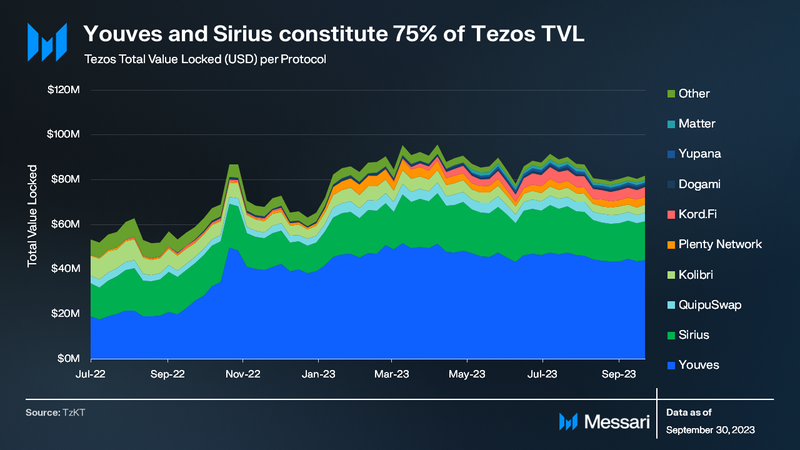
In Q3 ’23, Youves maintained its position as the leading protocol by TVL on Tezos, boasting a TVL of $44 million, which represents 54% of Tezos’s aggregate TVL. During the third quarter, Youves communicated changes to its strategic vision and roadmap. The platform’s adjustments include the redefinition of user roles to optimize leverage, the redirection of interest payments to liquidity providers, endorsement of native cross-chain assets, and an overhaul of its tokenomics. Furthermore, Youves introduced the Gold Tracker Token uXAU.
Following Youves, Sirius secured the second position, registering a TVL of $17 million, or 21% of Tezos’s total TVL. Subsequent protocols include Kord.Fi with a TVL of $4 million (5%), QuipuSwap at $4 million TVL (5%), Kolibri at $3 million TVL (4%), and Plenty Network, also at $3 million TVL (4%). Among them, Plenty Network marked the most significant QoQ jump, registering a +21% increase. During this quarter, Plenty launched Plenty V3 which included concentrated liquidity to enhance capital efficiency, range functionalities, and bolstered its suite of analytics and developer tools.
DeFi Diversity denotes the number of protocols comprising the top 90% of DeFi TVL. A wider spread of TVL across protocols can mitigate potential systemic risks from negative events. Tezos concluded Q3 with a DeFi Diversity score of 6.

Throughout 2023, Tezos’s stablecoin market capitalization has consistently been $50 million. Native-USDT leads the network with a market cap of $37 million, comprising 69% of Tezos’s entire stablecoin market. Subsequently, Youves’ uUSD is the second leading stablecoin on Tezos with a market capitalization of $12 million.
Additional Highlights
- Fireblocks integrates custody for Tezos (XTZ) tokens, encompassing both FA1.2 and FA2 token standards.
- Team Finance incorporates Tezos, streamlining token generation and management.
- Homebase enhances DAO management on Tezos with the introduction of off-chain voting and a governance token generation tool.
- Get Protocol secures $4.5 million in funding to challenge the ticketing industry stronghold, leveraging its Tezos-based NFT ticketing system.
- Fraktion, a French platform, aims to democratize real estate investment by tokenizing properties into security tokens within the next 12-18 months.
- TriliTech and Consensys developers built a bridge to add Tezos to MetaMask.
Closing Summary
In Q3 2023, Tezos showcased its versatility and adaptability amidst a challenging environment. The quarter highlighted a successful collaboration with La Poste Group and Nomadic Labs, resulting in the NFTimbre platform’s notable sales of 18,200 NFT stamps, totaling over €145,000 ($153,000).
Tezos continued its focus on developer engagement, ranking 18th with a dedicated community of 250 developers. Moreover, the integration with Fireblocks paved the way for increased institutional involvement. However, the quarter also witnessed challenges, particularly with the Oxford protocol proposal, which did not secure a supermajority. Once approved, this proposal promises to bring about pivotal changes, such as dynamic XTZ issuance and a new staking mechanism. The quarter also saw a slow down in address activity, while transactions remained steady.
Looking forward, Tezos will pass the Oxford upgrade and continue to update the base Tezos chain. Tezos faces immense competition at the base layer level, but the team continues to ship and develop the chain.




















